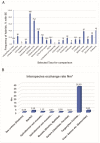Some Examples of the Use of Molecular Markers for Needs of Basic Biology and Modern Society
- PMID: 34065552
- PMCID: PMC8160991
- DOI: 10.3390/ani11051473
Some Examples of the Use of Molecular Markers for Needs of Basic Biology and Modern Society
Abstract
Application of molecular genetic markers appeared to be very fruitful in achieving many goals, including (i) proving the theoretic basements of general biology and (ii) assessment of worldwide biodiversity. Both are provided in the present meta-analysis and a review as the main signal. One of the basic current challenges in modern biology in the face of new demands in the 21st century is the validation of its paradigms such as the synthetic theory of evolution (STE) and biological species concept (BSC). Another of most valuable goals is the biodiversity assessment for a variety of social needs including free web-based information resources about any living being, renovation of museum collections, nature conservation that recognized as a global project, iBOL, as well as resolving global trading problems such as false labeling of species specimens used as food, drug components, entertainment, etc. The main issues of the review are focused on animals and combine four items. (1) A combination of nDNA and mtDNA markers best suits the identification of hybrids and estimation of genetic introgression. (2) The available facts on nDNA and mtDNA diversity seemingly make introgression among many taxa obvious, although it is evident, that introgression may be quite restricted or asymmetric, thus, leaving at least the "source" taxon (taxa) intact. (3) If we consider sexually reproducing species in marine and terrestrial realms introgressed, as it is still evident in many cases, then we should recognize that the BSC, in view of the complete lack of gene flow among species, is inadequate because many zoological species are not biological ones yet. However, vast modern molecular data have proven that sooner or later they definitely become biological species. (4) An investigation into the fish taxa divergence using the BOLD database shows that most gene trees are basically monophyletic and interspecies reticulations are quite rare.
Keywords: DNA barcoding; Neo-Darwinism; gene tree; genetic introgression; molecular evolution; mtDNA; nDNA; reticulation; species fate.
Conflict of interest statement
The author declare that the research was conducted in the absence of any commercial or financial relationships that could be construed as a potential conflict of interest.
Figures





Similar articles
-
Barcode index number, taxonomic rank and modes of speciation: examples from fish.Mitochondrial DNA A DNA Mapp Seq Anal. 2018 May;29(4):535-542. doi: 10.1080/24701394.2017.1315570. Epub 2017 May 8. Mitochondrial DNA A DNA Mapp Seq Anal. 2018. PMID: 28481646 Review.
-
Hydroids (Cnidaria, Hydrozoa) from Mauritanian Coral Mounds.Zootaxa. 2020 Nov 16;4878(3):zootaxa.4878.3.2. doi: 10.11646/zootaxa.4878.3.2. Zootaxa. 2020. PMID: 33311142
-
The Minderoo-Monaco Commission on Plastics and Human Health.Ann Glob Health. 2023 Mar 21;89(1):23. doi: 10.5334/aogh.4056. eCollection 2023. Ann Glob Health. 2023. PMID: 36969097 Free PMC article. Review.
-
Reticulate evolution within a spruce (Picea) species complex revealed by population genomic analysis.Evolution. 2018 Dec;72(12):2669-2681. doi: 10.1111/evo.13624. Epub 2018 Oct 26. Evolution. 2018. PMID: 30315582
-
[Foundations of the new phylogenetics].Zh Obshch Biol. 2004 Jul-Aug;65(4):334-66. Zh Obshch Biol. 2004. PMID: 15490579 Russian.
Cited by
-
Structure, Evolution, and Mitochondrial Genome Analysis of Mussel Species (Bivalvia, Mytilidae).Int J Mol Sci. 2024 Jun 24;25(13):6902. doi: 10.3390/ijms25136902. Int J Mol Sci. 2024. PMID: 39000014 Free PMC article.
-
Using Species Groups to Approach the Large and Taxonomically Unresolved Freshwater Fish Family Nemacheilidae (Teleostei: Cypriniformes).Biology (Basel). 2022 Jan 22;11(2):175. doi: 10.3390/biology11020175. Biology (Basel). 2022. PMID: 35205042 Free PMC article.
-
Characterization of the Complete Mitochondrial Genome of Angulyagra polyzonata and Its Phylogenetic Status in Viviparidae.Animals (Basel). 2025 Apr 30;15(9):1284. doi: 10.3390/ani15091284. Animals (Basel). 2025. PMID: 40362105 Free PMC article.
References
-
- Antonov A.S., Belozzerskii A.N. Comparative analysis of nucleotide composition of deoxyribonucleic acids of some vertebrates and invertebrates. Dokl. Akad. Nauk SSSR. 1961;138:1216–1220.
-
- Antonov A.S., Miroshnichenko G.P., Slyusarenko A.G. The data on DNA primary structure in the plant systematics. Usp. Sovrem. Biol. 1971;74:247–261.
Publication types
LinkOut - more resources
Full Text Sources
Research Materials

